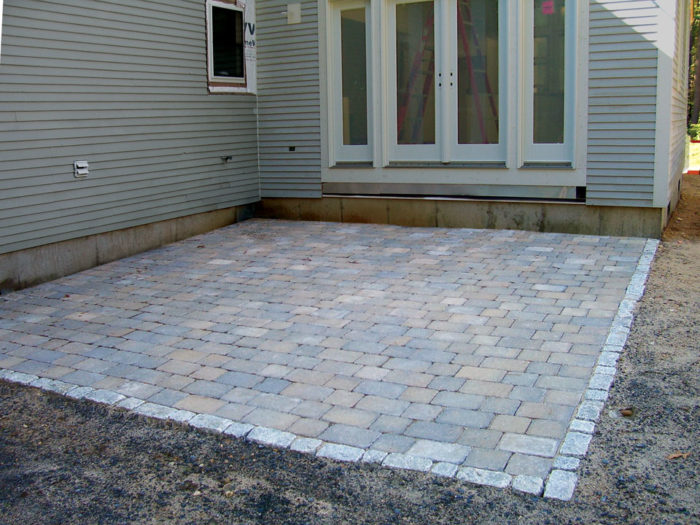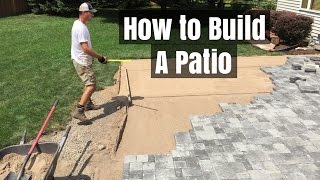To create a backyard patio, plan your design and gather materials. Follow with site preparation and installation steps.
A backyard patio enhances outdoor living space, providing a perfect spot for relaxation and entertainment. Begin by choosing a design that complements your home and meets your needs. Measure your space accurately to ensure a proper fit. Select quality materials like pavers, concrete, or natural stone for durability.
Prepare the site by clearing debris and leveling the ground. Install a solid base layer to prevent shifting. Lay the chosen material carefully, ensuring it’s even. Add finishing touches like furniture, lighting, and plants to complete your patio. Proper planning and execution will give you a beautiful and functional outdoor retreat.
Transforming Your Outdoor Space
Transforming your backyard patio into a beautiful retreat can elevate your home. It provides a perfect space for relaxation, entertainment, and family gatherings. With careful planning and thoughtful design, your outdoor area can become a sanctuary.
Inspiration And Design Ideas
First, gather inspiration and design ideas for your backyard patio. Browse home improvement magazines or websites. Visit local garden centers. Explore different styles like modern, rustic, or tropical. Create a mood board with your favorite elements. This helps you visualize your dream patio.
- Consider the layout and available space.
- Think about the functionality you need.
- Choose a theme that fits your taste.
Once you have a clear vision, sketch a rough plan. Include seating areas, pathways, and focal points. This will guide you through the process.
Setting A Budget
Setting a budget is crucial for your project. Determine how much you are willing to spend. Break down the costs into categories:
| Item | Estimated Cost |
|---|---|
| Materials (pavers, wood, etc.) | $500 – $2000 |
| Furniture | $300 – $1500 |
| Lighting | $100 – $500 |
| Plants | $100 – $400 |
| Labor | $200 – $1000 |
Create a detailed list of expenses. This helps you stay on track financially.
- Allocate funds for essential items first.
- Set aside a contingency fund for unexpected costs.
- Track your spending throughout the project.
By setting a realistic budget, you ensure a smooth and stress-free transformation of your outdoor space.
Choosing The Right Location
Planning a backyard patio starts with choosing the perfect location. The right spot makes your patio enjoyable and functional. Consider factors like sunlight, shade, privacy, and accessibility. Let’s break down these essential aspects to find the ideal spot for your patio.
Sunlight And Shade Considerations
Think about how much sunlight your patio will receive. Sunlight impacts comfort and usability. A sunny spot is great for morning coffee or sunbathing. But too much sun can make it uncomfortable during hot afternoons.
Check for natural shade from trees or structures. Shade provides a cool retreat. If your chosen spot lacks shade, consider adding a pergola or umbrella. This balance ensures your patio stays pleasant throughout the day.
Privacy And Accessibility
Privacy is crucial for a relaxing patio. Choose a spot away from neighbors’ views. Fences, plants, and screens can add extra privacy. This way, you can enjoy your space without feeling exposed.
Accessibility is equally important. Ensure the patio is easy to reach from your home. A spot near the kitchen is perfect for outdoor dining. Make sure pathways are clear and safe for all family members.
| Factor | Consideration |
|---|---|
| Sunlight | Perfect for morning activities |
| Shade | Necessary for afternoon comfort |
| Privacy | Choose a spot away from neighbors |
| Accessibility | Ensure easy access from home |
By considering these factors, you can choose the right location for your backyard patio. This ensures it will be a pleasant and functional space for everyone to enjoy.
Patio Materials And Options
Choosing the right materials for your backyard patio is essential. The choice impacts durability, aesthetics, and maintenance. Let’s explore some popular options to help you decide.
Concrete And Pavers
Concrete is a durable and versatile choice for patios. It can be stamped, stained, or textured. This makes it suitable for various styles. Concrete patios are also low-maintenance.
Pavers offer flexibility in design. They come in different shapes, sizes, and colors. Pavers are easy to install and replace. This makes them a popular choice for DIY projects.
Natural Stone And Tiles
Natural stone provides a luxurious look. Options include slate, granite, and limestone. Each stone has unique textures and colors. Natural stone requires more upkeep but lasts long.
Tiles are another elegant option. They come in ceramic, porcelain, and terracotta. Tiles are easy to clean and maintain. Ensure they are slip-resistant for safety.
Gravel And Decking
Gravel is an affordable and simple choice. It’s easy to install and allows for good drainage. Gravel patios have a rustic charm but may need frequent leveling.
Decking adds a warm, natural feel. Wood and composite decking are popular options. Wood requires regular maintenance, while composite is more durable.
| Material | Pros | Cons |
|---|---|---|
| Concrete | Durable, Versatile, Low-Maintenance | Can Crack Over Time |
| Pavers | Flexible Design, Easy to Replace | Can Shift or Sink |
| Natural Stone | Luxurious, Unique Textures | High Maintenance, Expensive |
| Tiles | Elegant, Easy to Clean | Can Be Slippery |
| Gravel | Affordable, Good Drainage | Needs Frequent Leveling |
| Decking | Warm, Natural Feel | Wood Requires Maintenance |

Credit: www.youtube.com
Preparing The Ground
Creating a backyard patio starts with a crucial step: preparing the ground. This foundation work ensures your patio remains sturdy and level. Let’s dive into the details of this process.
Measuring And Marking The Area
First, determine the size of your patio. Use a tape measure to get exact dimensions. Mark the area with stakes and string. Double-check your measurements to avoid errors. Make sure the corners are square. To ensure accuracy, measure diagonally from corner to corner.
Excavation And Leveling
Start by removing grass and topsoil from the marked area. Dig to a depth of 6 to 8 inches. This depth allows room for the base layers. Use a shovel for smaller areas or a mini-excavator for larger spaces.
Once excavated, level the ground. Check for evenness using a level tool. Fill any low spots with extra soil. Compact the ground using a plate compactor. Repeat until the surface is firm and even.
Now, your ground is ready for the next steps. You have a solid base for your backyard patio.
Laying The Foundation
Creating a backyard patio begins with a solid foundation. This ensures your patio remains stable and lasts for many years. The foundation includes preparing the ground, setting a solid base, and ensuring proper drainage.
Creating A Solid Base
The base is the most important part of your patio. Start by marking the area where your patio will be. Use stakes and string to outline the shape. Then, dig down about 6-8 inches. This depth ensures your patio will be stable.
Next, add a layer of gravel. This layer should be about 4 inches thick. Use a rake to spread the gravel evenly. Then, compact the gravel with a tamper. This step is crucial for a firm base. After compacting, add a 2-inch layer of sand. Smooth it out with a board. The sand layer helps level the surface.
Drainage Solutions
Proper drainage prevents water from pooling on your patio. Standing water can cause damage over time. To ensure good drainage, start by sloping the patio surface. A slope of 1/8 inch per foot is ideal. This allows water to flow away from the patio.
Another solution is installing a drain pipe. Place the pipe under the gravel layer. Make sure the pipe leads water away from the patio. You can also use a French drain. A French drain is a trench filled with gravel and a perforated pipe. This helps channel water away efficiently.
| Step | Task | Tools Needed |
|---|---|---|
| 1 | Mark the patio area | Stakes, string |
| 2 | Dig the base | Shovel |
| 3 | Add and compact gravel | Gravel, rake, tamper |
| 4 | Add sand layer | Sand, board |
| 5 | Ensure proper drainage | Drain pipe, French drain materials |

Credit: therosetable.com
Installation Techniques
Transforming your backyard into a stunning patio involves several steps. Understanding the right installation techniques can make the process smoother. This section will guide you through essential techniques to ensure a beautiful and durable patio.
Paving Patterns And Techniques
Choosing the right paving pattern can add a unique touch to your patio. Common patterns include:
- Herringbone: Adds a dynamic look with its zigzag design.
- Basket Weave: Mimics the look of woven baskets, offering a classic style.
- Running Bond: This staggered pattern is straightforward and popular.
- Circular: Perfect for round patios or focal points.
For installation, follow these steps:
- Lay a solid foundation using gravel and sand.
- Place pavers according to your chosen pattern.
- Ensure each paver is level by using a rubber mallet.
Securing And Finishing Touches
Securing your patio ensures longevity and stability. Here are some techniques:
- Edge Restraints: Install plastic or metal edge restraints to keep pavers in place.
- Polymeric Sand: Sweep this sand into the joints to lock pavers together.
Finishing touches can elevate your patio’s appearance:
- Add decorative elements like plants or outdoor furniture.
- Use sealant to protect pavers from stains and weather.
- Incorporate lighting for evening use and ambiance.
By following these techniques, your backyard patio will be both beautiful and functional.
Landscaping And Decor
Transforming your backyard patio into a serene retreat involves thoughtful landscaping and decor. The right elements can make your patio a favorite spot for relaxation. Below, find tips on selecting plants, furniture, and features.
Plant Selection
Choosing the right plants enhances your patio’s beauty. Opt for a mix of perennials and annuals for year-round color.
- Perennials: Lavender, Hostas, Ferns
- Annuals: Petunias, Marigolds, Impatiens
Use potted plants for flexibility. They are easy to move and rearrange. Hanging baskets add vertical interest. Herbs like basil and rosemary can double as decor and ingredients.
Furniture And Features
Choose comfortable furniture to make your patio inviting. A mix of seating options works best.
- Sofas with weather-resistant cushions
- Outdoor dining sets for meals
- Hammocks or hanging chairs for relaxation
Add features to enhance the patio experience. Consider these additions:
- Fire pits for warmth and ambiance
- Water features like fountains for a soothing sound
- Lighting for evening use, such as fairy lights or lanterns
For a final touch, include decorative elements. Throw pillows, outdoor rugs, and string lights can make the space cozy.
| Feature | Benefit |
|---|---|
| Fire Pit | Provides warmth and a gathering spot |
| Water Feature | Adds a calming sound |
| Lighting | Extends usability into the evening |

Credit: www.finegardening.com
Maintaining Your Patio
Maintaining your patio ensures it looks beautiful and lasts for years. Regular care prevents damage and saves money on repairs. Follow these tips to keep your backyard patio in top shape.
Regular Cleaning Tips
Cleaning your patio regularly keeps it looking fresh and inviting. Dirt and debris can cause stains and wear. Here are some simple tips:
- Sweep Weekly: Use a broom to remove leaves and dirt.
- Wash Monthly: Use a hose or pressure washer. Be gentle to avoid damage.
- Scrub Stains: Use mild soap and a brush for tough stains.
Regular cleaning prevents buildup and keeps your patio looking new. Use eco-friendly cleaners to protect your plants and pets.
Repair And Upkeep
Regular upkeep prevents small issues from becoming big problems. Inspect your patio for cracks and damage.
- Check for Cracks: Fill small cracks with sealant to prevent water damage.
- Repair Loose Stones: Re-secure loose stones with mortar.
- Seal Annually: Apply a sealant to protect against weather and stains.
Keep an eye on furniture and fixtures. Replace damaged items to maintain a cohesive look.
With regular cleaning and timely repairs, your patio will remain a beautiful outdoor space. Enjoy your well-maintained patio for years to come.
Frequently Asked Questions
How Do I Prepare My Yard For A Patio?
Clear the area of debris and vegetation. Measure and mark the patio boundaries. Excavate the soil to the required depth. Add a gravel base and compact it. Lay a sand layer and level it.
What Is The Cheapest Way To Make An Outdoor Patio?
Use gravel or mulch for the cheapest outdoor patio. Install DIY pavers or bricks for affordable options. Reclaimed materials also save costs.
How To Lay A Patio For Beginners?
Start by planning your patio layout. Clear the area and dig to a depth of 150mm. Add a layer of hardcore, then sand. Level and compact it. Lay the patio slabs, ensuring consistent spacing. Finally, fill gaps with jointing compound.
Can You Build A Patio By Yourself?
Yes, you can build a patio by yourself. Ensure you have the right tools and materials. Follow a detailed plan and safety guidelines.
How To Choose Materials For Patio?
Select durable, weather-resistant materials like concrete, pavers, or natural stone for your patio.
Conclusion
Creating a backyard patio is a rewarding project. It enhances your outdoor space and provides a relaxing retreat. Follow the steps outlined, and you’ll have a beautiful patio to enjoy. Start planning today and transform your backyard into a personal oasis.
Happy building!

